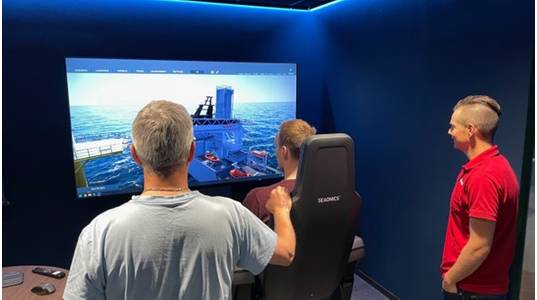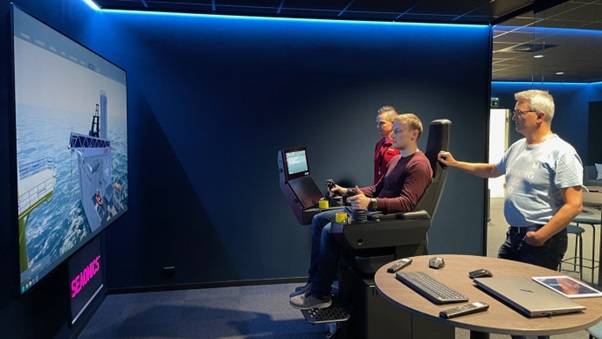
In the maritime and offshore energy and renewables industries, where precision and safety in handling and lifting solutions are paramount, the need for highly reliable and realistic training and testing solutions is critical, says Stig Espeseth, CTO of Norwegian motion-compensated gangway and crane technology vendor Seaonics.
At Seaonics, we are dedicated to enhancing the safety and efficiency of mission-critical operations through the development of our motion-compensated gangway and crane simulator. Our focus is not on ultra-flashy 3D visuals, but on delivering accurate, real-world performance. This approach underpins both our control system software development and our operator training programs, ensuring the highest levels of safety and operational effectiveness.
Critical operations demand realistic training
In scenarios such as landing technicians on a wind turbine using a motion-compensated gangway or offloading expensive equipment from a platform supply vessel (PSV) onto an offshore rig with a motion-compensated crane, accuracy is everything. An error could lead to catastrophic outcomes, endangering personnel and potentially causing costly damage to valuable assets. To mitigate these risks, our simulator is designed to provide operators with a highly realistic training environment, closely mirroring real-life conditions.
Going beyond mere visualization, our simulator replicates the actual physical behavior, sea states, weather conditions and potential system failures operators might encounter. This approach allows operators to practice handling challenging scenarios, such as vessel drift or sensor failures, ensuring they are well-prepared for any situation or alarm. The realism of our simulator helps build confidence and competence, making real-world operations safer and more efficient.
In-house development gives total control
At Seaonics, we pride ourselves in having developed our gangway and crane control systems in-house. This internal expertise allows us to fine-tune our systems with an unparalleled level of detail and accuracy. Our simulator plays a crucial role in this process, enabling us to test and validate control systems under realistic conditions before equipment is deployed in the field.
During software development, the simulator allows us to visualize and analyze system performance more effectively than traditional methods like graphs and software output variables. For example, we can simulate network dropouts and other anomalies, ensuring our systems are robust and reliable. The control systems are identical to those found on actual vessels, meaning we can test and validate updates with confidence, reducing the risk of unforeseen issues during real-world operations.

Training that reflects reality
Our training simulator is designed to be as close to the real operation as possible. They incorporate the actual hardware and control systems used on vessels, ensuring a seamless transition from training to real operations. Operators undergo a rigorous training program, including an obligatory three-day session at our Ålesund facility. They must complete at least 50 successful operations before receiving certification.
The simulators can be tailored to specific equipment and scenarios, such as landing personnel on a wind turbine or offloading equipment onto an offshore rig. Instructors can manipulate various parameters, including sea state, weather, and system failures, to provide a comprehensive training experience. This level of realism ensures that operators are well-prepared to handle real-world challenges effectively.
Realism rather than glitz
While it might be tempting to prioritize stunning 3D graphics, our focus is on accuracy and realism. Perfect behavior in a simulator can be misleading and counterproductive. Instead, we aim to replicate the true performance of our systems, accounting for factors such as sensor latency, signal processing delays, and real-world physical behaviors.
Our simulators accurately reflect the performance limitations and potential issues of our control systems, ensuring that operators are prepared for actual conditions. This includes simulating the effects of equipment location on a vessel, which can significantly impact performance. By providing a realistic training environment, we help operators develop the skills and knowledge needed to handle real-world operations safely and efficiently.
A holistic approach to simulation and training
Seaonics’ commitment to realistic simulation extends beyond operator training. Our simulators are integral to our control system development process, providing a consistent and reliable platform for testing and validation. This holistic approach ensures that our systems perform as expected, from initial development through to real-world deployment.
By maintaining full control over our simulation and training processes, we can guarantee the quality and reliability of our systems. This end-to-end control sets Seaonics apart in the industry. We are confident in the performance of our systems because they have been rigorously tested and validated under realistic conditions.
We believe that the key to successful mission-critical operations lies in realistic, accurate simulation and training. Our focus on replicating real-world conditions ensures that both our control systems and operators are prepared to meet the challenges they will face day to day at sea. This commitment to realism, safety, and performance underpins everything we do, driving us to continually innovate and improve our solutions.



